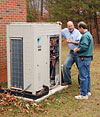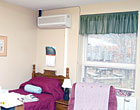
When considering the air conditioning and heating options for the Marjorie McCune Memorial Center in Black Mountain, N.C., electrical wiring, costs, individual resident control, and noise factors were just a few factors that entered the equation.
Within the facility, packaged terminal air conditioners (PTAC) were originally chosen as a cost-saving effort over a 4-pipe chiller system. Now decades old, this money-saving equipment choice is at the expense of sound, temperature, and humidity levels, as well as space saving and running costs, according to Jim Coates, maintenance supervisor for the McCune facility.
“We had to remove the PTACs, they had been in place for decades,” said Coates. “The units began requiring more frequent repairs, and they had become progressively more costly to run.”
In choosing a replacement for the existing PTACs and boiler, Coates had to not only consider these factors, but he also had to evaluate the potential disruption to the residents’ lives the replacement would cause. The first system proposed to Coates was to change the PTACs hot water coils to electric heat.
“But to do this, they would have had to completely revamp their electrical system and rewire every room in the building in order to accommodate the demands of electric heat,” said Stickels.
“So, I suggested they consider a Daikin VRV system instead. It would be simple to install, require greatly reduced electricity, keep everyone comfortable, and save energy costs. We investigated various system options and the bottom line was that the Daikin system was the most effective system for the money.”
Agreeing with Stickels, a Daikin Variable Refrigerant Volume (VRV®) system was chosen. According to the company, the system provides performance that is equivalent to a premium chiller system, in a package that is easy to install, cost effective, and allows each room’s temperature to be set at the resident’s personal preferences. The VRV units also saved space, reduced noise, and helped lower energy costs.
“The changeover was very successful,” said Coates.
Another benefit to the facility was that there was no need for a boiler. The previous system that heated and cooled the rooms operated with heat generated by a large hot water boiler. Coates noted that residents with the new system were able to keep the room comfortable in the cold winter months without one.
“That boiler had to keep running almost constantly during the heating season to supply water to the hot water coils in each PTAC,” explained Henry Snelson of Coastline Distribution, Hendersonville, N.C., the company that assisted in the engineering and sale of the Daikin system. “From the end of September through May, this very large and expensive-to-run boiler had to stay in operation. In contrast, the VRV provides efficient heat pump heating to individual areas, on demand, only when required.”

Each resident at the Marjorie McCune Memorial Center in Black Mountain, N.C., replaced its decades old heating and air conditioning system with a Daikin Variable Refrigerant Volume (VRV®) system.
TEMPERATURE CONTROL
The system installed at the McCune Center is comprised of two 6-ton heat pumps and one 8-ton heat pump unit, serving each of the facility’s three wings. FXAQ duct-free, wall-mounted units measuring approximately 11-by 31-by 9 inches serve each of the 32 zones. The indoor units have an individual PID controlled electronic refrigerant expansion valve that matches the amount of cooling or heating to the actual room load at any given time. According to Daikin, this ensures that the room temperature is held close to the set temperature and that continuous dehumidification occurs.“This is in comparison to a conventional system, which experiences fluctuations in dehumidification as a result of conventional on-off control,” said the company.
“Every VRV system includes a highly intelligent inverter-driven compressor that varies its speed, to supply only the amount of cooling or heating required by the actual load, thus eliminating expensive over-cooling or over-heating.”

The center provided individual comfort control with separate indoor units.
KEEPING EVERYONE HAPPY
According to Snelson, there were some initial concerns about moving from the existing hot water heating system to the technology of the Daikin heat pump VRV system.“The facility operators were apprehensive about making the change because of concerns about the heat pump’s operation in the cold months,” he explained. “But the data generated by a similar Daikin application installed in the very cold New England climate helped prove the effectiveness of the VRV system. Once they reviewed the data, they were ready to move forward.”
Daikin’s VRV system incorporates a patented piping system and a Daikin Intelligent Touch Controller - a color LCD touch-screen centralized controller - that gives the building administrator the ability to control each room’s temperature setting remotely, as well as a host of other functions. It connects up to 64 indoor unit groups and is located in the building engineer’s office. The controller can control the VRV heat pump system remotely and is capable of reporting a malfunction to a phone line or by available Web access.
Some features, such as the patented piping system design, helped accelerate the installation process.
“It was very important not to disrupt the lives of our residents during the renovation,” explained Coates. “They [technicians] were able to run the small diameter refrigerant lines above the ceiling and drop off connections into each room. Working along with an electrician, they could quickly handle the installation in stages, and leave in a very short time. I’d say they finished two, sometimes three rooms a day.”
After the entire installation was complete, Coates worked with each resident to fine-tune their room temperature to their wishes.
“We haven’t had one complaint about sound levels and the system has run without a problem. In fact, the outdoor units are also incredibly quiet, which both our staff and our residents have found to be remarkable,” noted Coates.
“We want everyone happy here, and the Daikin VRV gave us the flexibility to tailor the system to each individual.”
Publication Date:06/30/2008




